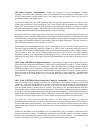28
16. SELECTION OF MEASUREMENT MODES AND OTHER
CONSIDERATIONS
16.1 General – In this last chapter I’ll discuss the advantages and disadvantages of the different
measuring modes used in our examples and some other measurement accuracy considerations along with
additional applications. Many measurements can be done in more than one of the measurement modes.
Usually when in doubt select the low distortion selective measuring mode for best general purpose use.
Some other measuring modes, like the carrier mode, actually set up the instrument similar to the low
distortion selective mode but they optimize the other settings thereby saving him setup time.
16.2 Low Distortion Selective – This measurement mode will give the most accurate level
measurement results for single signal measurements. However, if a signal is near the HP3586’s front end
and mixer’s noise floor of between –116db with phone filters and –120db with the 20 or 400HZ filters, a
level error can result. This is because the instrument’s internally generated noise level adds to the signals
level reading and may become a significant part of the total power in the instrument’s pass band. If
measurements are taken on weak signals on a band where there are very strong signals present but not in
the selected filter’s band pass, this mode will increase the instrument’s dynamic range by 10db and reduce
errors caused by spurious emissions generated within the instrument that may fall in the selected filter’s
pass band. This would be the case when taking signal measurements of a weak signal on a radio band, like
20 meters, when the band is very active with many strong signals. To test for this first try measuring in
low distortion, then switch to low noise, if the signal level reading decreases use the low noise reading. If
it increases use low distortion since spurious signals are present in the filter’s pass band.
16.3. Low Noise Selective – This mode is the most accurate when measuring weak signal near the noise
floor of the HP3586, i.e. signals less than –80dbm. This mode will lower the instrument’s noise floor by
5db. Since the instrument measures total noise power over the selected filter’s band pass, the white noise
generated in the instrument will add to the signals power causing a higher reading than that of the actual
signal. For signals above –80dbm this advantage is negligible and there is no advantage using this mode.
Also to reduce noise, always use the narrowest band pass filter possible for level measurements.
However since the HP3586’s front end is untuned and looks at all signals over it’s nearly 32MHz band
width, many signals besides the ones in its filter’s band pass will be present in its front end amplifier and
mixer. Harmonics of very strong signals can be generated in the HP3586’s RF untuned front end and then
mix causing spurious signals in the filter’s band pass. This is reduced in the low distortion mode by
increasing the instrument’s dynamic range by 10db at the cost of 5db more noise, so it’s a tradeoff which
mode to use.
For signals over –80dbm always use the low distortion mode. For weaker signals in an electronic circuit
being bench tested where the test signal is the only one present, the low noise mode should be used. For
signals in the presence of suspected strong signals first start by using the low distortion mode. If the
measured level is below –80dbm, try the test described in section 16.2. If the reading is lower in the low
noise mode use this level reading, if it’s higher you must use the level from the low distortion mode for
best level accuracy since spurious signals are causing an error in the reading.
16.4 Carrier – This mode is very similar to the low distortion selective mode but sets range and filter for
optimum accuracy for measuring single frequency signals like radio carriers. It is not available on the C
version so use the low distortion mode in its place on this model. However, if a signal’s level is –80dbn or
lower, try low noise selective and see if the reading drops. If the level reading drops, use low noise for a
more accurate level measurement being sure to use the 20Hz filter as discussed above in section 16.3.
16.5 Noise/Demodulation – This mode is intended for use with SSB channel noise measurements and
tuning SSB or wide band signals on telephone lines. It’s not available on the C version so the selective
level modes can be used, but not as easily. This mode is much easier to use for tuning SSB signals because
the frequency display will read the carrier frequency of the SSB signal instead of the RF frequency the


















